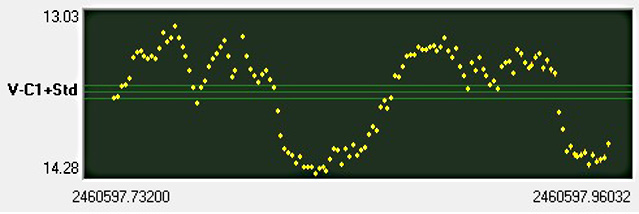AM Herculis
| Observation data Epoch J2000.0 Equinox J2000.0 | |
|---|---|
| Constellation | Hercules |
| Right ascension | 18h 16m 13.255s[2] |
| Declination | +49° 52′ 04.76″[2] |
| Apparent magnitude (V) | 12.30-15.7[3] |
| Characteristics | |
| Spectral type | pec + M4.5V[3] |
| Variable type | AM/XRM+E[3] |
| Astrometry | |
| Radial velocity (Rv) | -19.0[4] km/s |
| Proper motion (μ) | RA: −45.957[2] mas/yr Dec.: +28.046[2] mas/yr |
| Parallax (π) | 11.3953 ± 0.0179 mas[2] |
| Distance | 286.2 ± 0.4 ly (87.8 ± 0.1 pc) |
| Orbit | |
| Period (P) | 3.094 hours (variable)[5] |
| Eccentricity (e) | 0.47±0.21[6] |
| Inclination (i) | 50[5]° |
| Details | |
| White dwarf | |
| Mass | 0.6 - 0.7[5] M☉ |
| Red dwarf | |
| Mass | 0.26[6] M☉ |
| Radius | 0.32[6] R☉ |
| Other designations | |
| Database references | |
| SIMBAD | data |
AM Herculis is a binary variable star located in the constellation Hercules. This star, along with the star AN Ursae Majoris, is the prototype for a category of cataclysmic variable stars called polars, or AM Her type stars.
History
[edit]AM Herculis was first cataloged in 1923 by Max Wolf and was listed at the time as Veränderlicher 28.1923, which is now AN 28.1923 in the General Catalogue of Variable Stars. It was observed to be an irregular variable star ranging from 12 to 14 in apparent magnitude.[7] In 1976, the astronomer S. Tapia discovered that light from the star is both linearly and circularly polarized, showing that there was a strong magnetic field surrounding the system and revealing that the system was more complex than previously thought.[8][9][10]
System
[edit]The AM Herculis binary system contains a white dwarf and a red dwarf. The white dwarf is accreting material directly from the red dwarf without an accretion disk. The white dwarf primary is highly magnetic and the infalling material is channelled towards the magnetic poles. The accretion rate is unstable, at times decreasing dramatically and reducing the brightness of the whole system. There are also periodic variations thought to be caused by the appearance and eclipse of the accreting regions during rotation of the white dwarf.[5][6]

References
[edit]- ^ "Download Data". aavso.org. AAVSO. Retrieved 1 October 2021.
- ^ a b c d e Brown, A. G. A.; et al. (Gaia collaboration) (August 2018). "Gaia Data Release 2: Summary of the contents and survey properties". Astronomy & Astrophysics. 616. A1. arXiv:1804.09365. Bibcode:2018A&A...616A...1G. doi:10.1051/0004-6361/201833051. Gaia DR2 record for this source at VizieR.
- ^ a b c d "Query= AM Her". General Catalogue of Variable Stars. Centre de Données astronomiques de Strasbourg. Retrieved 2009-12-16.
- ^ Duflot, M.; Figon, P.; Meyssonnier, N. (1995). "Vitesses radiales. Catalogue WEB: Wilson Evans Batten. Subtittle: Radial velocities: The Wilson-Evans-Batten catalogue". Astronomy and Astrophysics Supplement Series. 114: 269. Bibcode:1995A&AS..114..269D.
- ^ a b c d Gawroński, M. P.; Goździewski, K.; Katarzyński, K.; Rycyk, G. (2018). "Another look at AM Herculis – radio-astrometric campaign with the e-EVN at 6 cm". Monthly Notices of the Royal Astronomical Society. 475 (1): 1399–1409. arXiv:1801.05815. Bibcode:2018MNRAS.475.1399G. doi:10.1093/mnras/stx3175. S2CID 54000035.
- ^ a b c d Dai, Zhibin; Qian, Shengbang; Li, Linjia; Rycyk, G. (2013). "Updated Photometry and Orbital Period Analysis for the Polar Am Herculis on the Upper Edge of the Period Gap". The Astrophysical Journal. 774 (2): 153. arXiv:1307.5135. Bibcode:2013ApJ...774..153D. doi:10.1088/0004-637X/774/2/153. S2CID 118843221.
- ^ S. Seliwanow (1923). "Mitteilungen über Veränderliche - Veränderlicher 28.1923 Herculis - M. Wolf - December 1923". Astronomische Nachrichten (in German). 220 (15): 255–256. Bibcode:1924AN....220..249H. doi:10.1002/asna.19232201505.
- ^ Tapia, S. (March 15, 1977). "Discovery of a magnetic compact star in the AM Herculis/3U 1809+50 system". The Astrophysical Journal Letters. 212: L125–L129. Bibcode:1977ApJ...212L.125T. doi:10.1086/182390.
- ^ Hessman, F.V.; Gansicke, B.T. & Mattei, J.A. (September 2000). "The history and source of mass-transfer variations in AM Herculis". Astronomy & Astrophysics. 361: 952–958. Bibcode:2000A&A...361..952H.
- ^ Krzeminski, W. & Serkowski, K. (August 1977). "Extremely high circular polarization of AN Ursae Majoris". The Astrophysical Journal Letters. 216: L45. Bibcode:1977ApJ...216L..45K. doi:10.1086/182506.
Further reading
[edit]- Coel Hellier (23 February 2001). Cataclysmic Variable Stars - How and Why They Vary. Springer Science & Business Media. pp. 13–. ISBN 978-1-85233-211-2.
- Cuno Hoffmeister; Gerold Richter; Wolfgang Wenzel (31 December 1985). Variable stars. Springer-Verlag. ISBN 978-3-540-13403-9.
- Liller, W. (1977). "The Story of AM Herculis". Sky and Telescope. 53: 351. Bibcode:1977S&T....53..351L.
External links
[edit]- Variable Star Of The Month by the American Association of Variable Star Observers

